Potential and Limitations of NbS in Chakaria, Bangladesh: A Report
VerifiedAdded on 2022/08/18
|71
|22555
|17
Report
AI Summary
This report examines the potential and limitations of Nature-based Solutions (NbS) in minimizing environmental degradation within the Chakaria Sub-district of Bangladesh's south-eastern coastal region. The study addresses the significant environmental challenges faced by the area, including the degradation of mangrove forests and loss of ecosystem services, exacerbated by human activities and natural hazards. It explores the effectiveness of NbS, integrated with existing policies, as a sustainable approach to mitigate these impacts, focusing on the restoration of biodiversity and ecosystem services. The research highlights the need for effective policy implementation and identifies challenges in applying NbS, aiming to contribute to the development of improved environmental conservation strategies. The report also provides a detailed literature review, methodology, and a plan for executing the project including the challenges and possible solutions that can be incorporated.
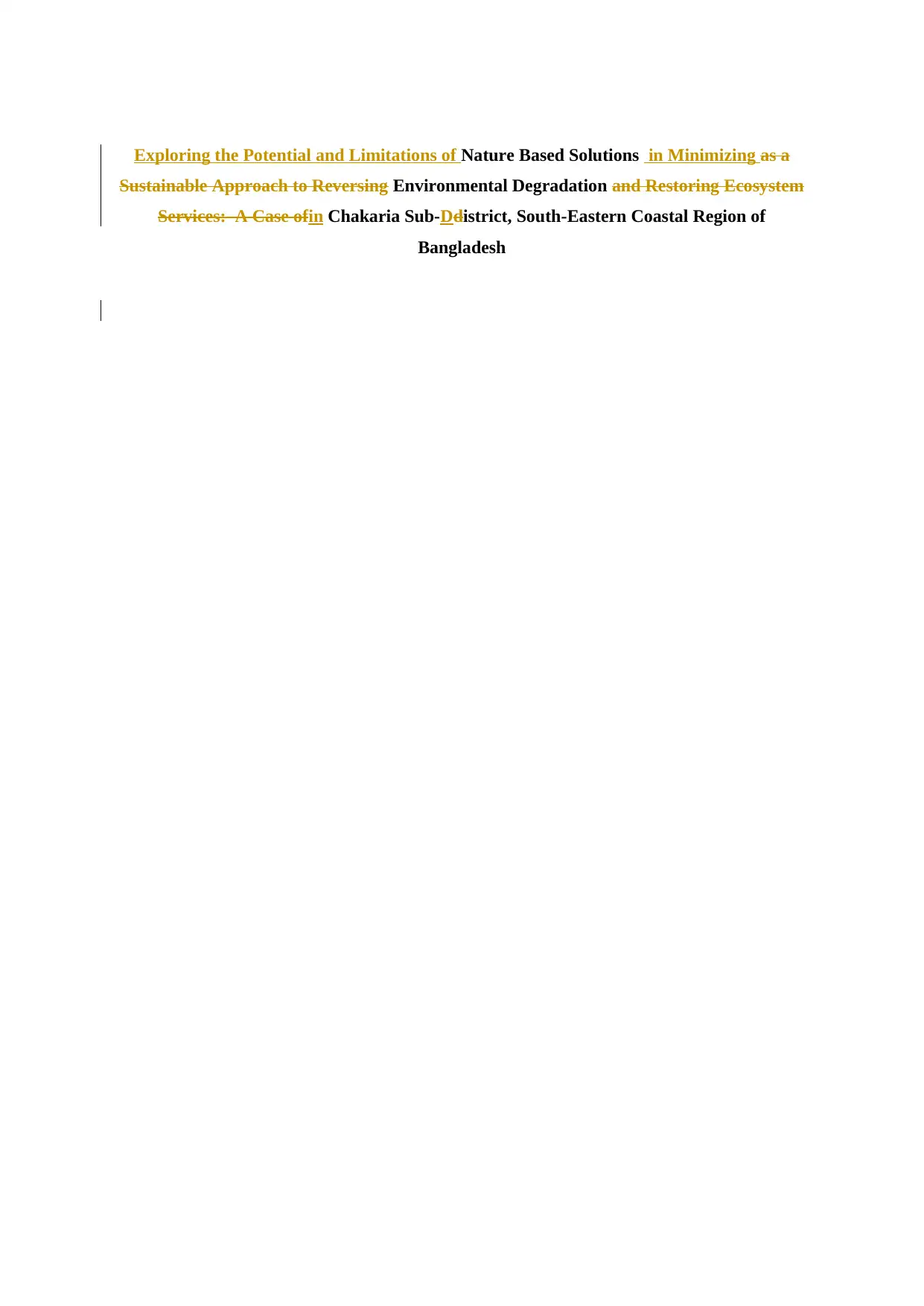
Exploring the Potential and Limitations of Nature Based Solutions in Minimizing as a
Sustainable Approach to Reversing Environmental Degradation and Restoring Ecosystem
Services: A Case ofin Chakaria Sub-Ddistrict, South-Eastern Coastal Region of
Bangladesh
Sustainable Approach to Reversing Environmental Degradation and Restoring Ecosystem
Services: A Case ofin Chakaria Sub-Ddistrict, South-Eastern Coastal Region of
Bangladesh
Paraphrase This Document
Need a fresh take? Get an instant paraphrase of this document with our AI Paraphraser
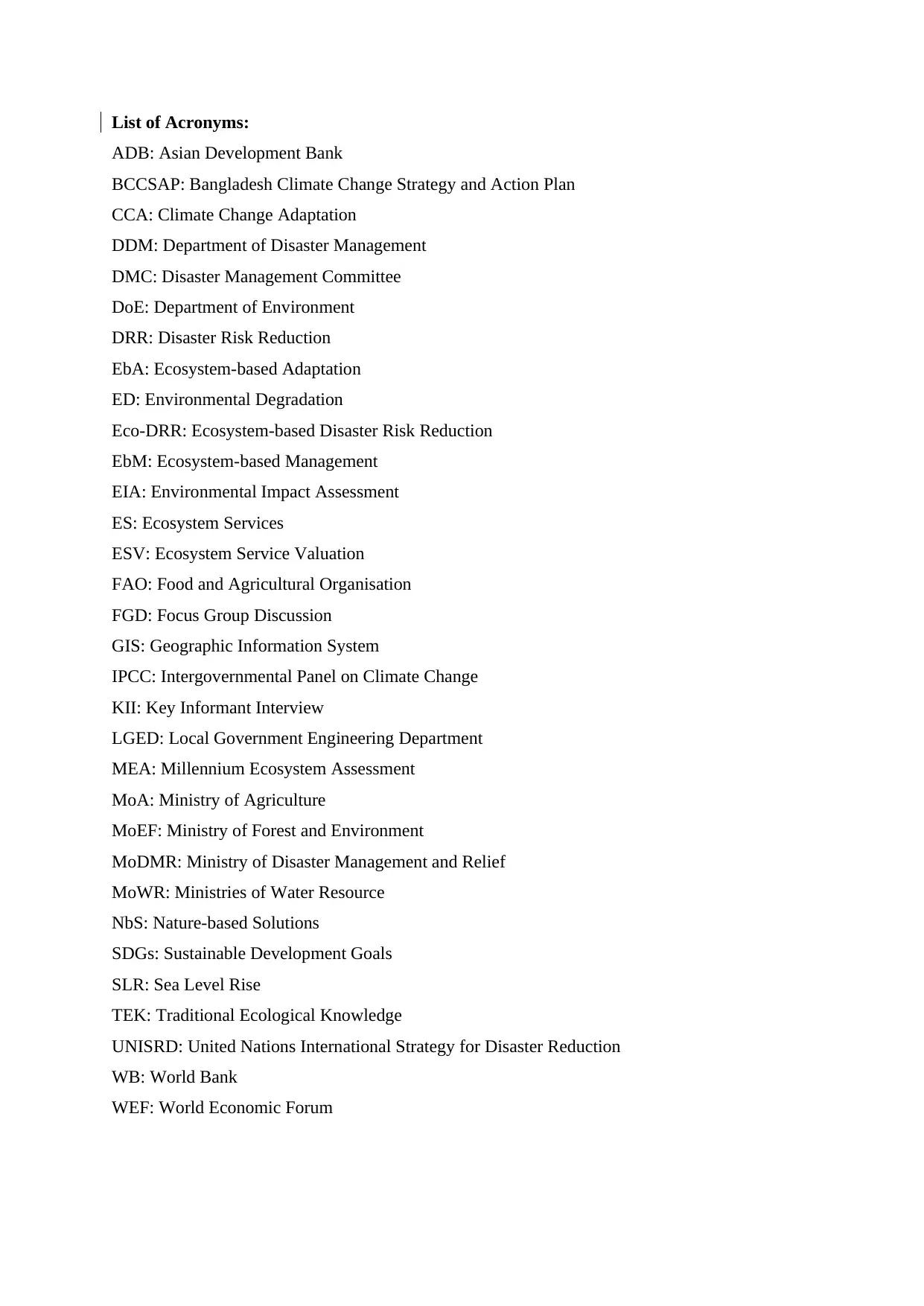
List of Acronyms:
ADB: Asian Development Bank
BCCSAP: Bangladesh Climate Change Strategy and Action Plan
CCA: Climate Change Adaptation
DDM: Department of Disaster Management
DMC: Disaster Management Committee
DoE: Department of Environment
DRR: Disaster Risk Reduction
EbA: Ecosystem-based Adaptation
ED: Environmental Degradation
Eco-DRR: Ecosystem-based Disaster Risk Reduction
EbM: Ecosystem-based Management
EIA: Environmental Impact Assessment
ES: Ecosystem Services
ESV: Ecosystem Service Valuation
FAO: Food and Agricultural Organisation
FGD: Focus Group Discussion
GIS: Geographic Information System
IPCC: Intergovernmental Panel on Climate Change
KII: Key Informant Interview
LGED: Local Government Engineering Department
MEA: Millennium Ecosystem Assessment
MoA: Ministry of Agriculture
MoEF: Ministry of Forest and Environment
MoDMR: Ministry of Disaster Management and Relief
MoWR: Ministries of Water Resource
NbS: Nature-based Solutions
SDGs: Sustainable Development Goals
SLR: Sea Level Rise
TEK: Traditional Ecological Knowledge
UNISRD: United Nations International Strategy for Disaster Reduction
WB: World Bank
WEF: World Economic Forum
ADB: Asian Development Bank
BCCSAP: Bangladesh Climate Change Strategy and Action Plan
CCA: Climate Change Adaptation
DDM: Department of Disaster Management
DMC: Disaster Management Committee
DoE: Department of Environment
DRR: Disaster Risk Reduction
EbA: Ecosystem-based Adaptation
ED: Environmental Degradation
Eco-DRR: Ecosystem-based Disaster Risk Reduction
EbM: Ecosystem-based Management
EIA: Environmental Impact Assessment
ES: Ecosystem Services
ESV: Ecosystem Service Valuation
FAO: Food and Agricultural Organisation
FGD: Focus Group Discussion
GIS: Geographic Information System
IPCC: Intergovernmental Panel on Climate Change
KII: Key Informant Interview
LGED: Local Government Engineering Department
MEA: Millennium Ecosystem Assessment
MoA: Ministry of Agriculture
MoEF: Ministry of Forest and Environment
MoDMR: Ministry of Disaster Management and Relief
MoWR: Ministries of Water Resource
NbS: Nature-based Solutions
SDGs: Sustainable Development Goals
SLR: Sea Level Rise
TEK: Traditional Ecological Knowledge
UNISRD: United Nations International Strategy for Disaster Reduction
WB: World Bank
WEF: World Economic Forum
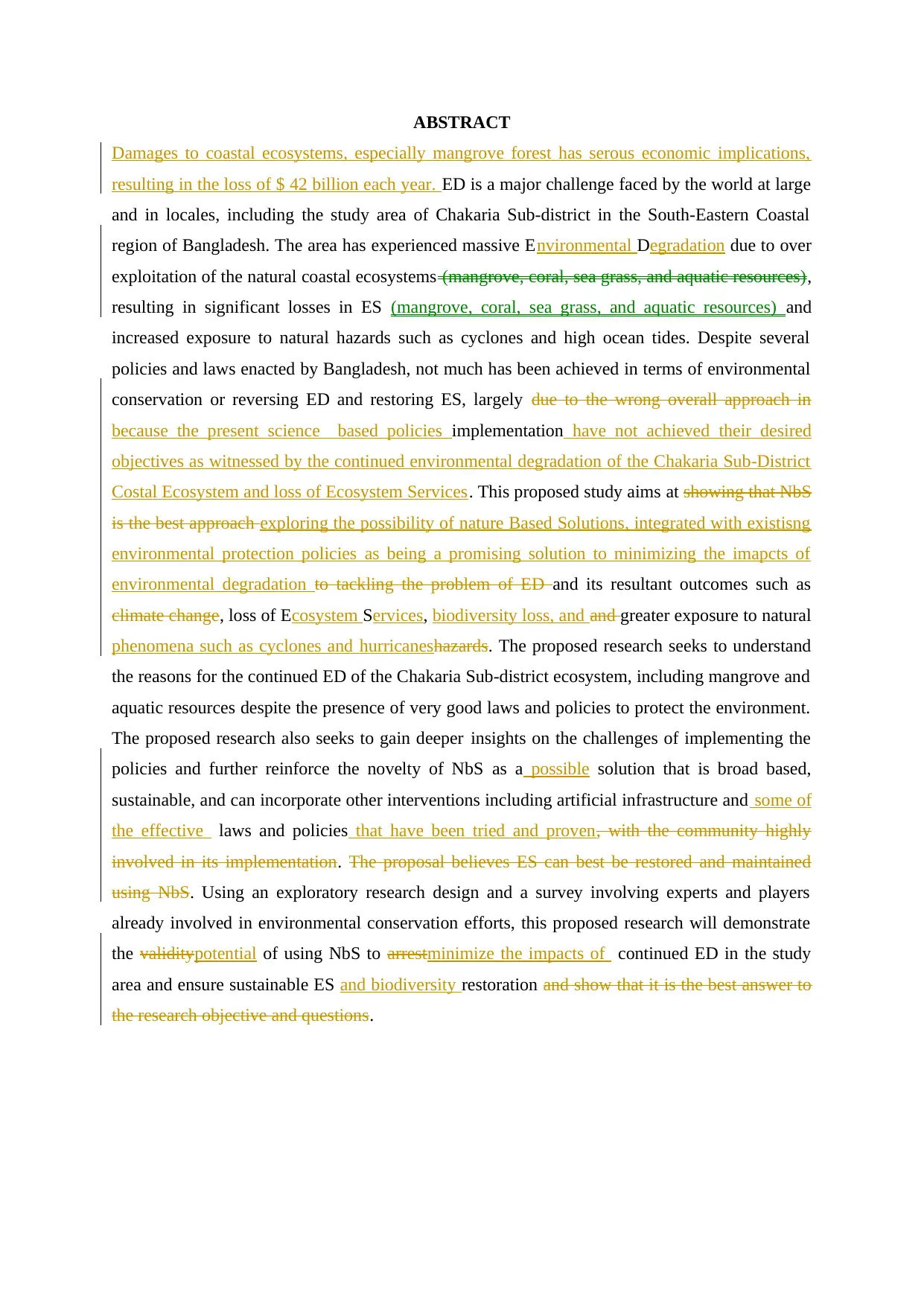
ABSTRACT
Damages to coastal ecosystems, especially mangrove forest has serous economic implications,
resulting in the loss of $ 42 billion each year. ED is a major challenge faced by the world at large
and in locales, including the study area of Chakaria Sub-district in the South-Eastern Coastal
region of Bangladesh. The area has experienced massive Environmental Degradation due to over
exploitation of the natural coastal ecosystems (mangrove, coral, sea grass, and aquatic resources),
resulting in significant losses in ES (mangrove, coral, sea grass, and aquatic resources) and
increased exposure to natural hazards such as cyclones and high ocean tides. Despite several
policies and laws enacted by Bangladesh, not much has been achieved in terms of environmental
conservation or reversing ED and restoring ES, largely due to the wrong overall approach in
because the present science based policies implementation have not achieved their desired
objectives as witnessed by the continued environmental degradation of the Chakaria Sub-District
Costal Ecosystem and loss of Ecosystem Services. This proposed study aims at showing that NbS
is the best approach exploring the possibility of nature Based Solutions, integrated with existisng
environmental protection policies as being a promising solution to minimizing the imapcts of
environmental degradation to tackling the problem of ED and its resultant outcomes such as
climate change, loss of Ecosystem Services, biodiversity loss, and and greater exposure to natural
phenomena such as cyclones and hurricaneshazards. The proposed research seeks to understand
the reasons for the continued ED of the Chakaria Sub-district ecosystem, including mangrove and
aquatic resources despite the presence of very good laws and policies to protect the environment.
The proposed research also seeks to gain deeper insights on the challenges of implementing the
policies and further reinforce the novelty of NbS as a possible solution that is broad based,
sustainable, and can incorporate other interventions including artificial infrastructure and some of
the effective laws and policies that have been tried and proven, with the community highly
involved in its implementation. The proposal believes ES can best be restored and maintained
using NbS. Using an exploratory research design and a survey involving experts and players
already involved in environmental conservation efforts, this proposed research will demonstrate
the validitypotential of using NbS to arrestminimize the impacts of continued ED in the study
area and ensure sustainable ES and biodiversity restoration and show that it is the best answer to
the research objective and questions.
Damages to coastal ecosystems, especially mangrove forest has serous economic implications,
resulting in the loss of $ 42 billion each year. ED is a major challenge faced by the world at large
and in locales, including the study area of Chakaria Sub-district in the South-Eastern Coastal
region of Bangladesh. The area has experienced massive Environmental Degradation due to over
exploitation of the natural coastal ecosystems (mangrove, coral, sea grass, and aquatic resources),
resulting in significant losses in ES (mangrove, coral, sea grass, and aquatic resources) and
increased exposure to natural hazards such as cyclones and high ocean tides. Despite several
policies and laws enacted by Bangladesh, not much has been achieved in terms of environmental
conservation or reversing ED and restoring ES, largely due to the wrong overall approach in
because the present science based policies implementation have not achieved their desired
objectives as witnessed by the continued environmental degradation of the Chakaria Sub-District
Costal Ecosystem and loss of Ecosystem Services. This proposed study aims at showing that NbS
is the best approach exploring the possibility of nature Based Solutions, integrated with existisng
environmental protection policies as being a promising solution to minimizing the imapcts of
environmental degradation to tackling the problem of ED and its resultant outcomes such as
climate change, loss of Ecosystem Services, biodiversity loss, and and greater exposure to natural
phenomena such as cyclones and hurricaneshazards. The proposed research seeks to understand
the reasons for the continued ED of the Chakaria Sub-district ecosystem, including mangrove and
aquatic resources despite the presence of very good laws and policies to protect the environment.
The proposed research also seeks to gain deeper insights on the challenges of implementing the
policies and further reinforce the novelty of NbS as a possible solution that is broad based,
sustainable, and can incorporate other interventions including artificial infrastructure and some of
the effective laws and policies that have been tried and proven, with the community highly
involved in its implementation. The proposal believes ES can best be restored and maintained
using NbS. Using an exploratory research design and a survey involving experts and players
already involved in environmental conservation efforts, this proposed research will demonstrate
the validitypotential of using NbS to arrestminimize the impacts of continued ED in the study
area and ensure sustainable ES and biodiversity restoration and show that it is the best answer to
the research objective and questions.
⊘ This is a preview!⊘
Do you want full access?
Subscribe today to unlock all pages.

Trusted by 1+ million students worldwide

Paraphrase This Document
Need a fresh take? Get an instant paraphrase of this document with our AI Paraphraser
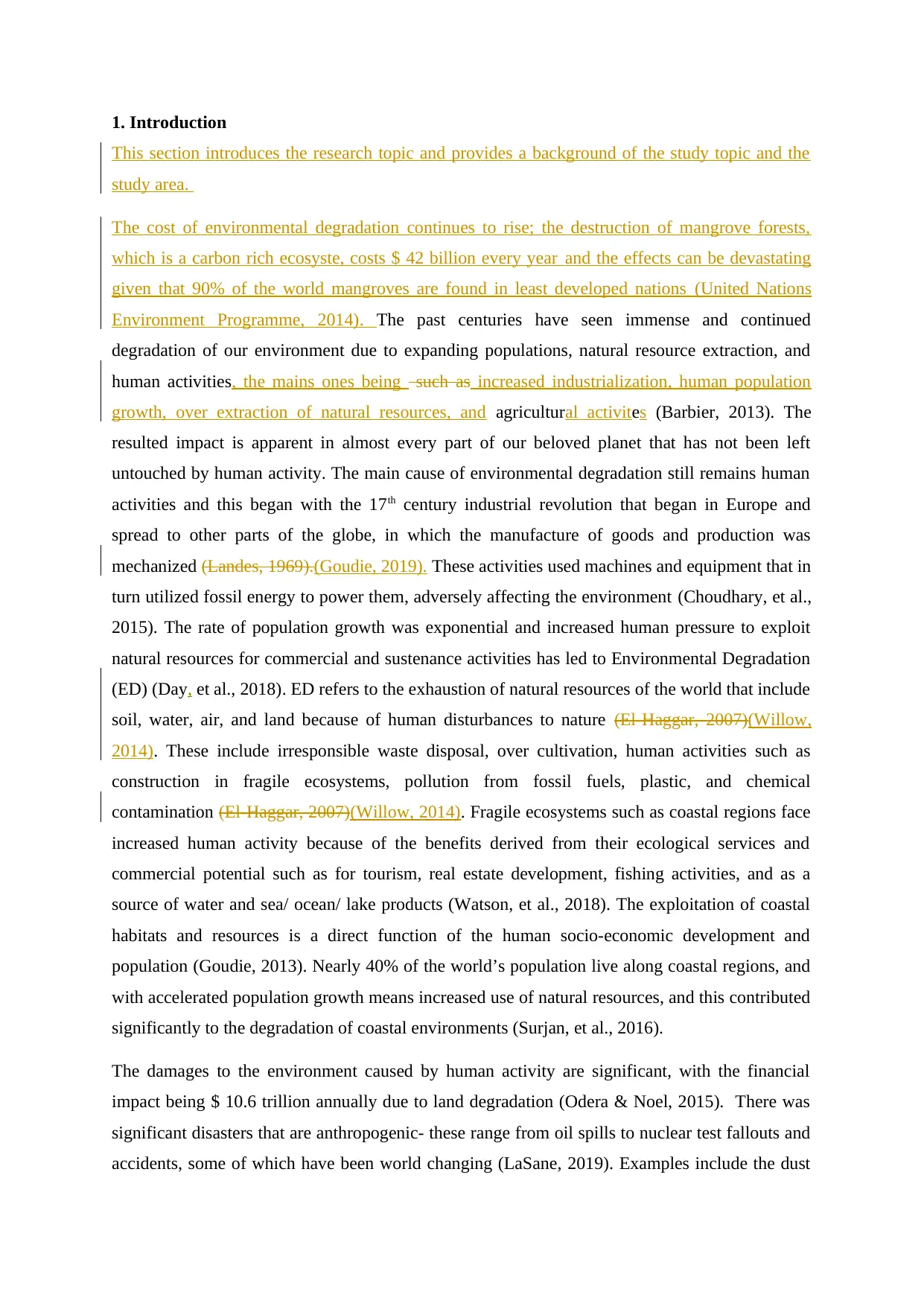
1. Introduction
This section introduces the research topic and provides a background of the study topic and the
study area.
The cost of environmental degradation continues to rise; the destruction of mangrove forests,
which is a carbon rich ecosyste, costs $ 42 billion every year and the effects can be devastating
given that 90% of the world mangroves are found in least developed nations (United Nations
Environment Programme, 2014). The past centuries have seen immense and continued
degradation of our environment due to expanding populations, natural resource extraction, and
human activities, the mains ones being such as increased industrialization, human population
growth, over extraction of natural resources, and agricultural activites (Barbier, 2013). The
resulted impact is apparent in almost every part of our beloved planet that has not been left
untouched by human activity. The main cause of environmental degradation still remains human
activities and this began with the 17th century industrial revolution that began in Europe and
spread to other parts of the globe, in which the manufacture of goods and production was
mechanized (Landes, 1969).(Goudie, 2019). These activities used machines and equipment that in
turn utilized fossil energy to power them, adversely affecting the environment (Choudhary, et al.,
2015). The rate of population growth was exponential and increased human pressure to exploit
natural resources for commercial and sustenance activities has led to Environmental Degradation
(ED) (Day, et al., 2018). ED refers to the exhaustion of natural resources of the world that include
soil, water, air, and land because of human disturbances to nature (El-Haggar, 2007)(Willow,
2014). These include irresponsible waste disposal, over cultivation, human activities such as
construction in fragile ecosystems, pollution from fossil fuels, plastic, and chemical
contamination (El-Haggar, 2007)(Willow, 2014). Fragile ecosystems such as coastal regions face
increased human activity because of the benefits derived from their ecological services and
commercial potential such as for tourism, real estate development, fishing activities, and as a
source of water and sea/ ocean/ lake products (Watson, et al., 2018). The exploitation of coastal
habitats and resources is a direct function of the human socio-economic development and
population (Goudie, 2013). Nearly 40% of the world’s population live along coastal regions, and
with accelerated population growth means increased use of natural resources, and this contributed
significantly to the degradation of coastal environments (Surjan, et al., 2016).
The damages to the environment caused by human activity are significant, with the financial
impact being $ 10.6 trillion annually due to land degradation (Odera & Noel, 2015). There was
significant disasters that are anthropogenic- these range from oil spills to nuclear test fallouts and
accidents, some of which have been world changing (LaSane, 2019). Examples include the dust
This section introduces the research topic and provides a background of the study topic and the
study area.
The cost of environmental degradation continues to rise; the destruction of mangrove forests,
which is a carbon rich ecosyste, costs $ 42 billion every year and the effects can be devastating
given that 90% of the world mangroves are found in least developed nations (United Nations
Environment Programme, 2014). The past centuries have seen immense and continued
degradation of our environment due to expanding populations, natural resource extraction, and
human activities, the mains ones being such as increased industrialization, human population
growth, over extraction of natural resources, and agricultural activites (Barbier, 2013). The
resulted impact is apparent in almost every part of our beloved planet that has not been left
untouched by human activity. The main cause of environmental degradation still remains human
activities and this began with the 17th century industrial revolution that began in Europe and
spread to other parts of the globe, in which the manufacture of goods and production was
mechanized (Landes, 1969).(Goudie, 2019). These activities used machines and equipment that in
turn utilized fossil energy to power them, adversely affecting the environment (Choudhary, et al.,
2015). The rate of population growth was exponential and increased human pressure to exploit
natural resources for commercial and sustenance activities has led to Environmental Degradation
(ED) (Day, et al., 2018). ED refers to the exhaustion of natural resources of the world that include
soil, water, air, and land because of human disturbances to nature (El-Haggar, 2007)(Willow,
2014). These include irresponsible waste disposal, over cultivation, human activities such as
construction in fragile ecosystems, pollution from fossil fuels, plastic, and chemical
contamination (El-Haggar, 2007)(Willow, 2014). Fragile ecosystems such as coastal regions face
increased human activity because of the benefits derived from their ecological services and
commercial potential such as for tourism, real estate development, fishing activities, and as a
source of water and sea/ ocean/ lake products (Watson, et al., 2018). The exploitation of coastal
habitats and resources is a direct function of the human socio-economic development and
population (Goudie, 2013). Nearly 40% of the world’s population live along coastal regions, and
with accelerated population growth means increased use of natural resources, and this contributed
significantly to the degradation of coastal environments (Surjan, et al., 2016).
The damages to the environment caused by human activity are significant, with the financial
impact being $ 10.6 trillion annually due to land degradation (Odera & Noel, 2015). There was
significant disasters that are anthropogenic- these range from oil spills to nuclear test fallouts and
accidents, some of which have been world changing (LaSane, 2019). Examples include the dust
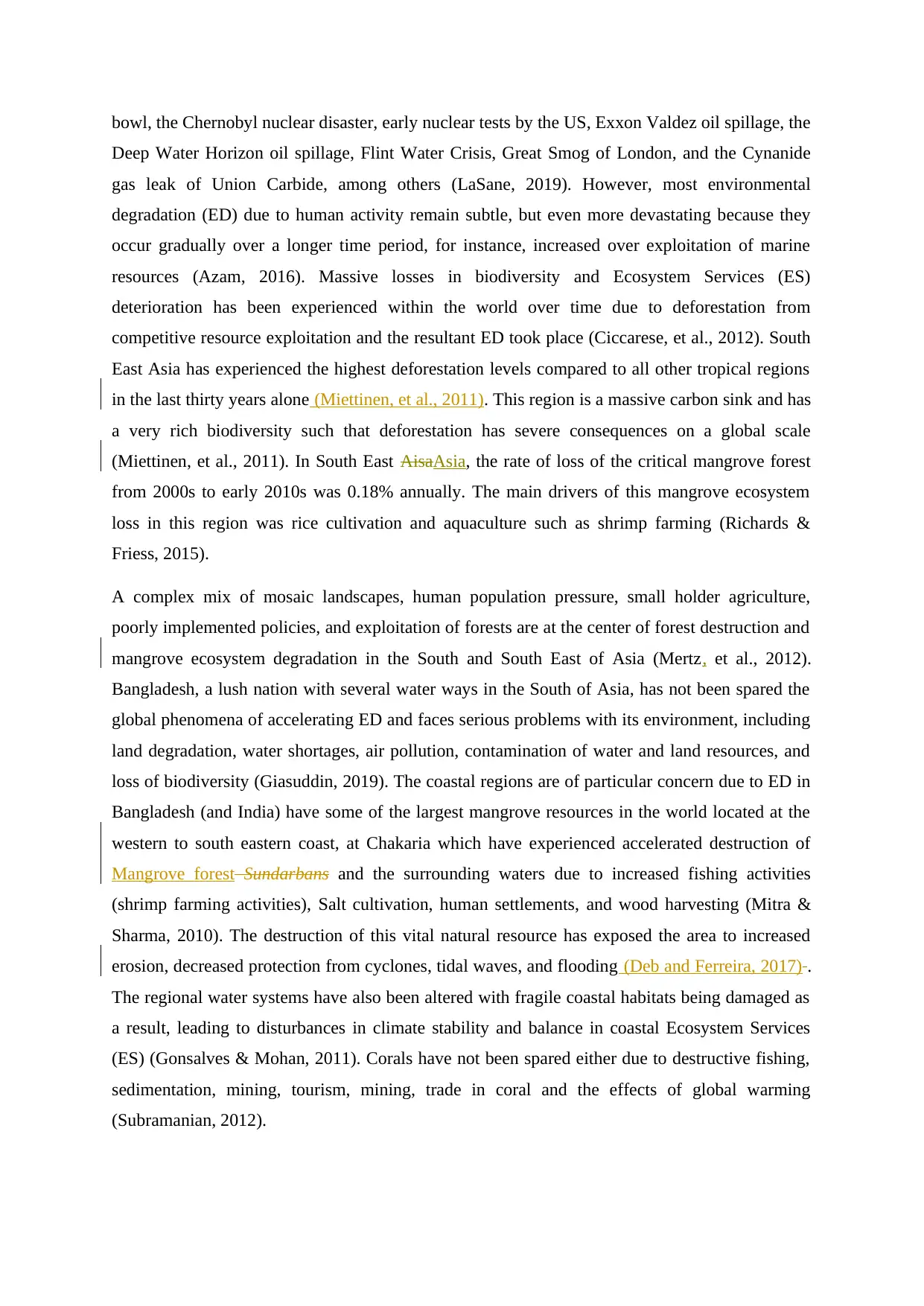
bowl, the Chernobyl nuclear disaster, early nuclear tests by the US, Exxon Valdez oil spillage, the
Deep Water Horizon oil spillage, Flint Water Crisis, Great Smog of London, and the Cynanide
gas leak of Union Carbide, among others (LaSane, 2019). However, most environmental
degradation (ED) due to human activity remain subtle, but even more devastating because they
occur gradually over a longer time period, for instance, increased over exploitation of marine
resources (Azam, 2016). Massive losses in biodiversity and Ecosystem Services (ES)
deterioration has been experienced within the world over time due to deforestation from
competitive resource exploitation and the resultant ED took place (Ciccarese, et al., 2012). South
East Asia has experienced the highest deforestation levels compared to all other tropical regions
in the last thirty years alone (Miettinen, et al., 2011). This region is a massive carbon sink and has
a very rich biodiversity such that deforestation has severe consequences on a global scale
(Miettinen, et al., 2011). In South East AisaAsia, the rate of loss of the critical mangrove forest
from 2000s to early 2010s was 0.18% annually. The main drivers of this mangrove ecosystem
loss in this region was rice cultivation and aquaculture such as shrimp farming (Richards &
Friess, 2015).
A complex mix of mosaic landscapes, human population pressure, small holder agriculture,
poorly implemented policies, and exploitation of forests are at the center of forest destruction and
mangrove ecosystem degradation in the South and South East of Asia (Mertz, et al., 2012).
Bangladesh, a lush nation with several water ways in the South of Asia, has not been spared the
global phenomena of accelerating ED and faces serious problems with its environment, including
land degradation, water shortages, air pollution, contamination of water and land resources, and
loss of biodiversity (Giasuddin, 2019). The coastal regions are of particular concern due to ED in
Bangladesh (and India) have some of the largest mangrove resources in the world located at the
western to south eastern coast, at Chakaria which have experienced accelerated destruction of
Mangrove forest Sundarbans and the surrounding waters due to increased fishing activities
(shrimp farming activities), Salt cultivation, human settlements, and wood harvesting (Mitra &
Sharma, 2010). The destruction of this vital natural resource has exposed the area to increased
erosion, decreased protection from cyclones, tidal waves, and flooding (Deb and Ferreira, 2017) .
The regional water systems have also been altered with fragile coastal habitats being damaged as
a result, leading to disturbances in climate stability and balance in coastal Ecosystem Services
(ES) (Gonsalves & Mohan, 2011). Corals have not been spared either due to destructive fishing,
sedimentation, mining, tourism, mining, trade in coral and the effects of global warming
(Subramanian, 2012).
Deep Water Horizon oil spillage, Flint Water Crisis, Great Smog of London, and the Cynanide
gas leak of Union Carbide, among others (LaSane, 2019). However, most environmental
degradation (ED) due to human activity remain subtle, but even more devastating because they
occur gradually over a longer time period, for instance, increased over exploitation of marine
resources (Azam, 2016). Massive losses in biodiversity and Ecosystem Services (ES)
deterioration has been experienced within the world over time due to deforestation from
competitive resource exploitation and the resultant ED took place (Ciccarese, et al., 2012). South
East Asia has experienced the highest deforestation levels compared to all other tropical regions
in the last thirty years alone (Miettinen, et al., 2011). This region is a massive carbon sink and has
a very rich biodiversity such that deforestation has severe consequences on a global scale
(Miettinen, et al., 2011). In South East AisaAsia, the rate of loss of the critical mangrove forest
from 2000s to early 2010s was 0.18% annually. The main drivers of this mangrove ecosystem
loss in this region was rice cultivation and aquaculture such as shrimp farming (Richards &
Friess, 2015).
A complex mix of mosaic landscapes, human population pressure, small holder agriculture,
poorly implemented policies, and exploitation of forests are at the center of forest destruction and
mangrove ecosystem degradation in the South and South East of Asia (Mertz, et al., 2012).
Bangladesh, a lush nation with several water ways in the South of Asia, has not been spared the
global phenomena of accelerating ED and faces serious problems with its environment, including
land degradation, water shortages, air pollution, contamination of water and land resources, and
loss of biodiversity (Giasuddin, 2019). The coastal regions are of particular concern due to ED in
Bangladesh (and India) have some of the largest mangrove resources in the world located at the
western to south eastern coast, at Chakaria which have experienced accelerated destruction of
Mangrove forest Sundarbans and the surrounding waters due to increased fishing activities
(shrimp farming activities), Salt cultivation, human settlements, and wood harvesting (Mitra &
Sharma, 2010). The destruction of this vital natural resource has exposed the area to increased
erosion, decreased protection from cyclones, tidal waves, and flooding (Deb and Ferreira, 2017) .
The regional water systems have also been altered with fragile coastal habitats being damaged as
a result, leading to disturbances in climate stability and balance in coastal Ecosystem Services
(ES) (Gonsalves & Mohan, 2011). Corals have not been spared either due to destructive fishing,
sedimentation, mining, tourism, mining, trade in coral and the effects of global warming
(Subramanian, 2012).
⊘ This is a preview!⊘
Do you want full access?
Subscribe today to unlock all pages.

Trusted by 1+ million students worldwide
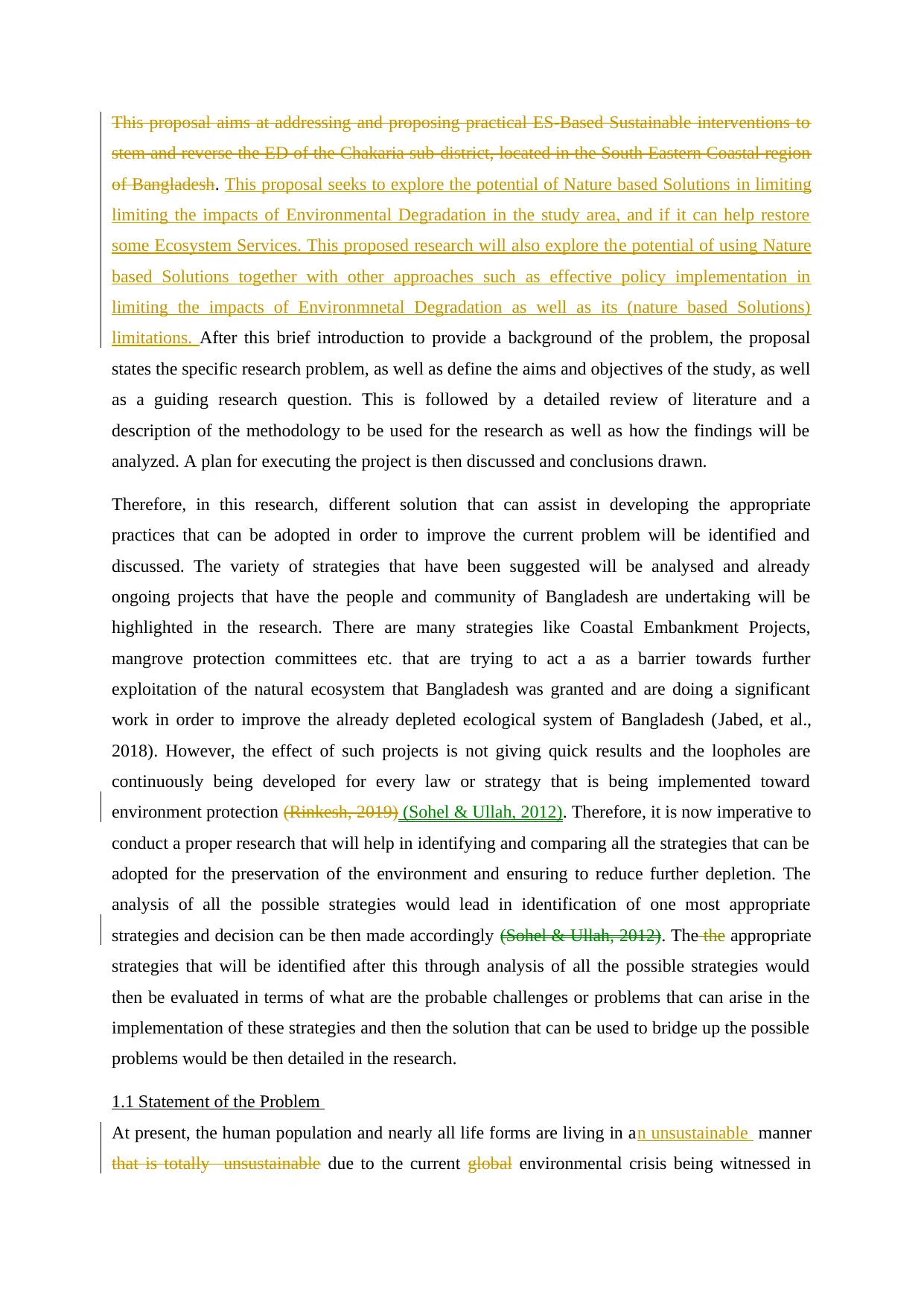
This proposal aims at addressing and proposing practical ES-Based Sustainable interventions to
stem and reverse the ED of the Chakaria sub-district, located in the South Eastern Coastal region
of Bangladesh. This proposal seeks to explore the potential of Nature based Solutions in limiting
limiting the impacts of Environmental Degradation in the study area, and if it can help restore
some Ecosystem Services. This proposed research will also explore the potential of using Nature
based Solutions together with other approaches such as effective policy implementation in
limiting the impacts of Environmnetal Degradation as well as its (nature based Solutions)
limitations. After this brief introduction to provide a background of the problem, the proposal
states the specific research problem, as well as define the aims and objectives of the study, as well
as a guiding research question. This is followed by a detailed review of literature and a
description of the methodology to be used for the research as well as how the findings will be
analyzed. A plan for executing the project is then discussed and conclusions drawn.
Therefore, in this research, different solution that can assist in developing the appropriate
practices that can be adopted in order to improve the current problem will be identified and
discussed. The variety of strategies that have been suggested will be analysed and already
ongoing projects that have the people and community of Bangladesh are undertaking will be
highlighted in the research. There are many strategies like Coastal Embankment Projects,
mangrove protection committees etc. that are trying to act a as a barrier towards further
exploitation of the natural ecosystem that Bangladesh was granted and are doing a significant
work in order to improve the already depleted ecological system of Bangladesh (Jabed, et al.,
2018). However, the effect of such projects is not giving quick results and the loopholes are
continuously being developed for every law or strategy that is being implemented toward
environment protection (Rinkesh, 2019) (Sohel & Ullah, 2012). Therefore, it is now imperative to
conduct a proper research that will help in identifying and comparing all the strategies that can be
adopted for the preservation of the environment and ensuring to reduce further depletion. The
analysis of all the possible strategies would lead in identification of one most appropriate
strategies and decision can be then made accordingly (Sohel & Ullah, 2012). The the appropriate
strategies that will be identified after this through analysis of all the possible strategies would
then be evaluated in terms of what are the probable challenges or problems that can arise in the
implementation of these strategies and then the solution that can be used to bridge up the possible
problems would be then detailed in the research.
1.1 Statement of the Problem
At present, the human population and nearly all life forms are living in an unsustainable manner
that is totally unsustainable due to the current global environmental crisis being witnessed in
stem and reverse the ED of the Chakaria sub-district, located in the South Eastern Coastal region
of Bangladesh. This proposal seeks to explore the potential of Nature based Solutions in limiting
limiting the impacts of Environmental Degradation in the study area, and if it can help restore
some Ecosystem Services. This proposed research will also explore the potential of using Nature
based Solutions together with other approaches such as effective policy implementation in
limiting the impacts of Environmnetal Degradation as well as its (nature based Solutions)
limitations. After this brief introduction to provide a background of the problem, the proposal
states the specific research problem, as well as define the aims and objectives of the study, as well
as a guiding research question. This is followed by a detailed review of literature and a
description of the methodology to be used for the research as well as how the findings will be
analyzed. A plan for executing the project is then discussed and conclusions drawn.
Therefore, in this research, different solution that can assist in developing the appropriate
practices that can be adopted in order to improve the current problem will be identified and
discussed. The variety of strategies that have been suggested will be analysed and already
ongoing projects that have the people and community of Bangladesh are undertaking will be
highlighted in the research. There are many strategies like Coastal Embankment Projects,
mangrove protection committees etc. that are trying to act a as a barrier towards further
exploitation of the natural ecosystem that Bangladesh was granted and are doing a significant
work in order to improve the already depleted ecological system of Bangladesh (Jabed, et al.,
2018). However, the effect of such projects is not giving quick results and the loopholes are
continuously being developed for every law or strategy that is being implemented toward
environment protection (Rinkesh, 2019) (Sohel & Ullah, 2012). Therefore, it is now imperative to
conduct a proper research that will help in identifying and comparing all the strategies that can be
adopted for the preservation of the environment and ensuring to reduce further depletion. The
analysis of all the possible strategies would lead in identification of one most appropriate
strategies and decision can be then made accordingly (Sohel & Ullah, 2012). The the appropriate
strategies that will be identified after this through analysis of all the possible strategies would
then be evaluated in terms of what are the probable challenges or problems that can arise in the
implementation of these strategies and then the solution that can be used to bridge up the possible
problems would be then detailed in the research.
1.1 Statement of the Problem
At present, the human population and nearly all life forms are living in an unsustainable manner
that is totally unsustainable due to the current global environmental crisis being witnessed in
Paraphrase This Document
Need a fresh take? Get an instant paraphrase of this document with our AI Paraphraser
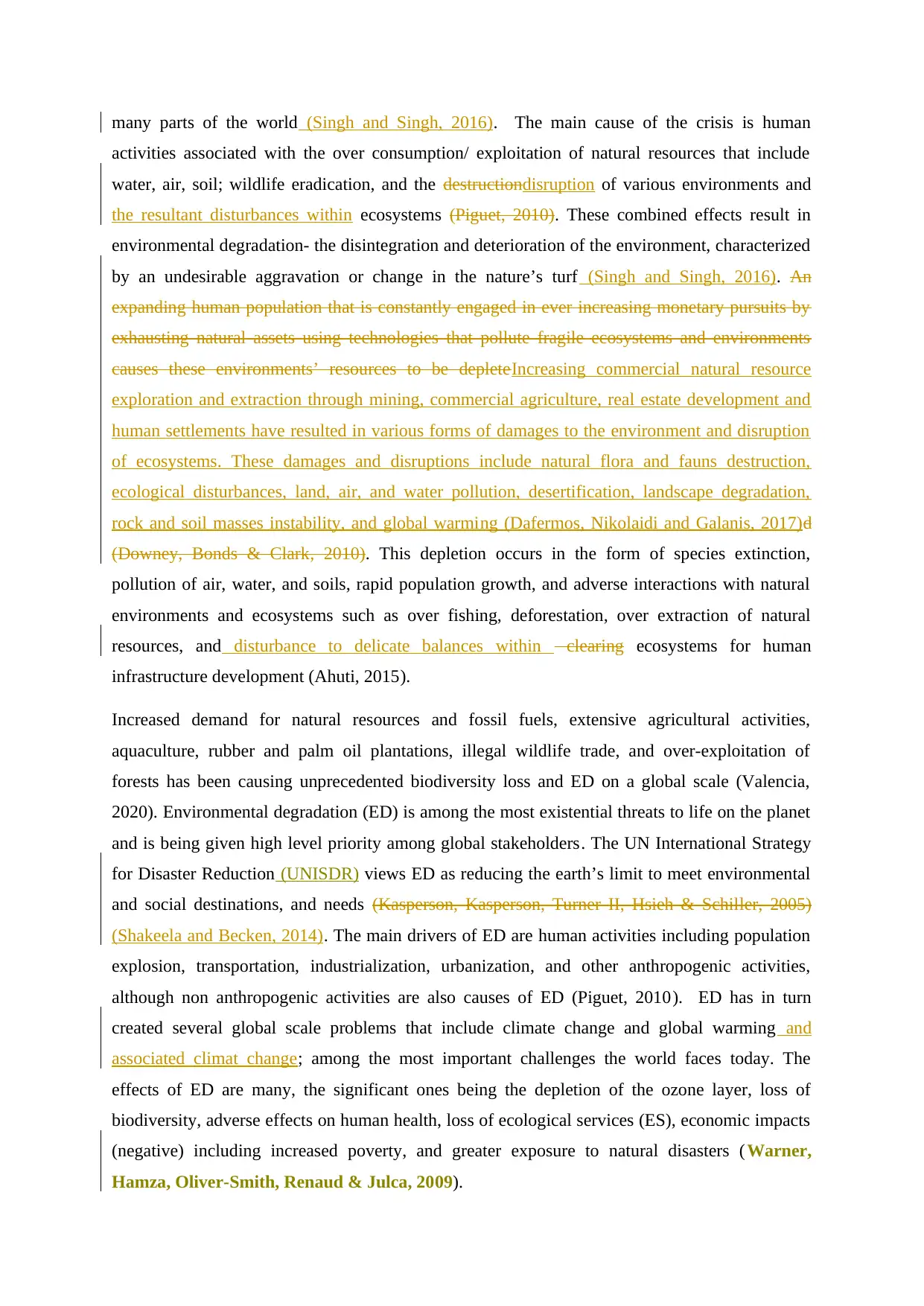
many parts of the world (Singh and Singh, 2016). The main cause of the crisis is human
activities associated with the over consumption/ exploitation of natural resources that include
water, air, soil; wildlife eradication, and the destructiondisruption of various environments and
the resultant disturbances within ecosystems (Piguet, 2010). These combined effects result in
environmental degradation- the disintegration and deterioration of the environment, characterized
by an undesirable aggravation or change in the nature’s turf (Singh and Singh, 2016). An
expanding human population that is constantly engaged in ever increasing monetary pursuits by
exhausting natural assets using technologies that pollute fragile ecosystems and environments
causes these environments’ resources to be depleteIncreasing commercial natural resource
exploration and extraction through mining, commercial agriculture, real estate development and
human settlements have resulted in various forms of damages to the environment and disruption
of ecosystems. These damages and disruptions include natural flora and fauns destruction,
ecological disturbances, land, air, and water pollution, desertification, landscape degradation,
rock and soil masses instability, and global warming (Dafermos, Nikolaidi and Galanis, 2017)d
(Downey, Bonds & Clark, 2010). This depletion occurs in the form of species extinction,
pollution of air, water, and soils, rapid population growth, and adverse interactions with natural
environments and ecosystems such as over fishing, deforestation, over extraction of natural
resources, and disturbance to delicate balances within clearing ecosystems for human
infrastructure development (Ahuti, 2015).
Increased demand for natural resources and fossil fuels, extensive agricultural activities,
aquaculture, rubber and palm oil plantations, illegal wildlife trade, and over-exploitation of
forests has been causing unprecedented biodiversity loss and ED on a global scale (Valencia,
2020). Environmental degradation (ED) is among the most existential threats to life on the planet
and is being given high level priority among global stakeholders. The UN International Strategy
for Disaster Reduction (UNISDR) views ED as reducing the earth’s limit to meet environmental
and social destinations, and needs (Kasperson, Kasperson, Turner II, Hsieh & Schiller, 2005)
(Shakeela and Becken, 2014). The main drivers of ED are human activities including population
explosion, transportation, industrialization, urbanization, and other anthropogenic activities,
although non anthropogenic activities are also causes of ED (Piguet, 2010). ED has in turn
created several global scale problems that include climate change and global warming and
associated climat change; among the most important challenges the world faces today. The
effects of ED are many, the significant ones being the depletion of the ozone layer, loss of
biodiversity, adverse effects on human health, loss of ecological services (ES), economic impacts
(negative) including increased poverty, and greater exposure to natural disasters (Warner,
Hamza, Oliver-Smith, Renaud & Julca, 2009).
activities associated with the over consumption/ exploitation of natural resources that include
water, air, soil; wildlife eradication, and the destructiondisruption of various environments and
the resultant disturbances within ecosystems (Piguet, 2010). These combined effects result in
environmental degradation- the disintegration and deterioration of the environment, characterized
by an undesirable aggravation or change in the nature’s turf (Singh and Singh, 2016). An
expanding human population that is constantly engaged in ever increasing monetary pursuits by
exhausting natural assets using technologies that pollute fragile ecosystems and environments
causes these environments’ resources to be depleteIncreasing commercial natural resource
exploration and extraction through mining, commercial agriculture, real estate development and
human settlements have resulted in various forms of damages to the environment and disruption
of ecosystems. These damages and disruptions include natural flora and fauns destruction,
ecological disturbances, land, air, and water pollution, desertification, landscape degradation,
rock and soil masses instability, and global warming (Dafermos, Nikolaidi and Galanis, 2017)d
(Downey, Bonds & Clark, 2010). This depletion occurs in the form of species extinction,
pollution of air, water, and soils, rapid population growth, and adverse interactions with natural
environments and ecosystems such as over fishing, deforestation, over extraction of natural
resources, and disturbance to delicate balances within clearing ecosystems for human
infrastructure development (Ahuti, 2015).
Increased demand for natural resources and fossil fuels, extensive agricultural activities,
aquaculture, rubber and palm oil plantations, illegal wildlife trade, and over-exploitation of
forests has been causing unprecedented biodiversity loss and ED on a global scale (Valencia,
2020). Environmental degradation (ED) is among the most existential threats to life on the planet
and is being given high level priority among global stakeholders. The UN International Strategy
for Disaster Reduction (UNISDR) views ED as reducing the earth’s limit to meet environmental
and social destinations, and needs (Kasperson, Kasperson, Turner II, Hsieh & Schiller, 2005)
(Shakeela and Becken, 2014). The main drivers of ED are human activities including population
explosion, transportation, industrialization, urbanization, and other anthropogenic activities,
although non anthropogenic activities are also causes of ED (Piguet, 2010). ED has in turn
created several global scale problems that include climate change and global warming and
associated climat change; among the most important challenges the world faces today. The
effects of ED are many, the significant ones being the depletion of the ozone layer, loss of
biodiversity, adverse effects on human health, loss of ecological services (ES), economic impacts
(negative) including increased poverty, and greater exposure to natural disasters (Warner,
Hamza, Oliver-Smith, Renaud & Julca, 2009).
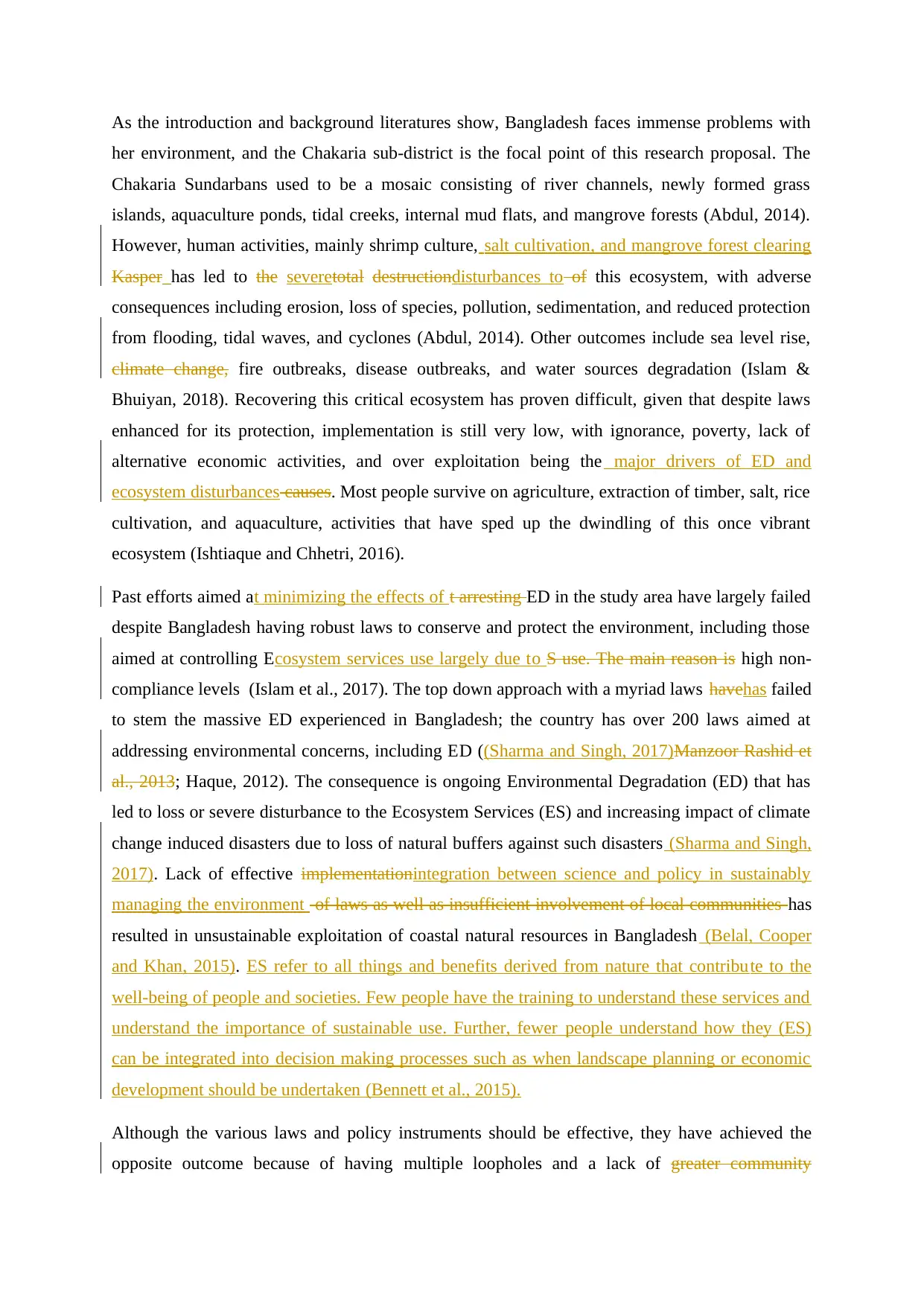
As the introduction and background literatures show, Bangladesh faces immense problems with
her environment, and the Chakaria sub-district is the focal point of this research proposal. The
Chakaria Sundarbans used to be a mosaic consisting of river channels, newly formed grass
islands, aquaculture ponds, tidal creeks, internal mud flats, and mangrove forests (Abdul, 2014).
However, human activities, mainly shrimp culture, salt cultivation, and mangrove forest clearing
Kasper has led to the severetotal destructiondisturbances to of this ecosystem, with adverse
consequences including erosion, loss of species, pollution, sedimentation, and reduced protection
from flooding, tidal waves, and cyclones (Abdul, 2014). Other outcomes include sea level rise,
climate change, fire outbreaks, disease outbreaks, and water sources degradation (Islam &
Bhuiyan, 2018). Recovering this critical ecosystem has proven difficult, given that despite laws
enhanced for its protection, implementation is still very low, with ignorance, poverty, lack of
alternative economic activities, and over exploitation being the major drivers of ED and
ecosystem disturbances causes. Most people survive on agriculture, extraction of timber, salt, rice
cultivation, and aquaculture, activities that have sped up the dwindling of this once vibrant
ecosystem (Ishtiaque and Chhetri, 2016).
Past efforts aimed at minimizing the effects of t arresting ED in the study area have largely failed
despite Bangladesh having robust laws to conserve and protect the environment, including those
aimed at controlling Ecosystem services use largely due to S use. The main reason is high non-
compliance levels (Islam et al., 2017). The top down approach with a myriad laws havehas failed
to stem the massive ED experienced in Bangladesh; the country has over 200 laws aimed at
addressing environmental concerns, including ED ((Sharma and Singh, 2017)Manzoor Rashid et
al., 2013; Haque, 2012). The consequence is ongoing Environmental Degradation (ED) that has
led to loss or severe disturbance to the Ecosystem Services (ES) and increasing impact of climate
change induced disasters due to loss of natural buffers against such disasters (Sharma and Singh,
2017). Lack of effective implementationintegration between science and policy in sustainably
managing the environment of laws as well as insufficient involvement of local communities has
resulted in unsustainable exploitation of coastal natural resources in Bangladesh (Belal, Cooper
and Khan, 2015). ES refer to all things and benefits derived from nature that contribute to the
well-being of people and societies. Few people have the training to understand these services and
understand the importance of sustainable use. Further, fewer people understand how they (ES)
can be integrated into decision making processes such as when landscape planning or economic
development should be undertaken (Bennett et al., 2015).
Although the various laws and policy instruments should be effective, they have achieved the
opposite outcome because of having multiple loopholes and a lack of greater community
her environment, and the Chakaria sub-district is the focal point of this research proposal. The
Chakaria Sundarbans used to be a mosaic consisting of river channels, newly formed grass
islands, aquaculture ponds, tidal creeks, internal mud flats, and mangrove forests (Abdul, 2014).
However, human activities, mainly shrimp culture, salt cultivation, and mangrove forest clearing
Kasper has led to the severetotal destructiondisturbances to of this ecosystem, with adverse
consequences including erosion, loss of species, pollution, sedimentation, and reduced protection
from flooding, tidal waves, and cyclones (Abdul, 2014). Other outcomes include sea level rise,
climate change, fire outbreaks, disease outbreaks, and water sources degradation (Islam &
Bhuiyan, 2018). Recovering this critical ecosystem has proven difficult, given that despite laws
enhanced for its protection, implementation is still very low, with ignorance, poverty, lack of
alternative economic activities, and over exploitation being the major drivers of ED and
ecosystem disturbances causes. Most people survive on agriculture, extraction of timber, salt, rice
cultivation, and aquaculture, activities that have sped up the dwindling of this once vibrant
ecosystem (Ishtiaque and Chhetri, 2016).
Past efforts aimed at minimizing the effects of t arresting ED in the study area have largely failed
despite Bangladesh having robust laws to conserve and protect the environment, including those
aimed at controlling Ecosystem services use largely due to S use. The main reason is high non-
compliance levels (Islam et al., 2017). The top down approach with a myriad laws havehas failed
to stem the massive ED experienced in Bangladesh; the country has over 200 laws aimed at
addressing environmental concerns, including ED ((Sharma and Singh, 2017)Manzoor Rashid et
al., 2013; Haque, 2012). The consequence is ongoing Environmental Degradation (ED) that has
led to loss or severe disturbance to the Ecosystem Services (ES) and increasing impact of climate
change induced disasters due to loss of natural buffers against such disasters (Sharma and Singh,
2017). Lack of effective implementationintegration between science and policy in sustainably
managing the environment of laws as well as insufficient involvement of local communities has
resulted in unsustainable exploitation of coastal natural resources in Bangladesh (Belal, Cooper
and Khan, 2015). ES refer to all things and benefits derived from nature that contribute to the
well-being of people and societies. Few people have the training to understand these services and
understand the importance of sustainable use. Further, fewer people understand how they (ES)
can be integrated into decision making processes such as when landscape planning or economic
development should be undertaken (Bennett et al., 2015).
Although the various laws and policy instruments should be effective, they have achieved the
opposite outcome because of having multiple loopholes and a lack of greater community
⊘ This is a preview!⊘
Do you want full access?
Subscribe today to unlock all pages.

Trusted by 1+ million students worldwide
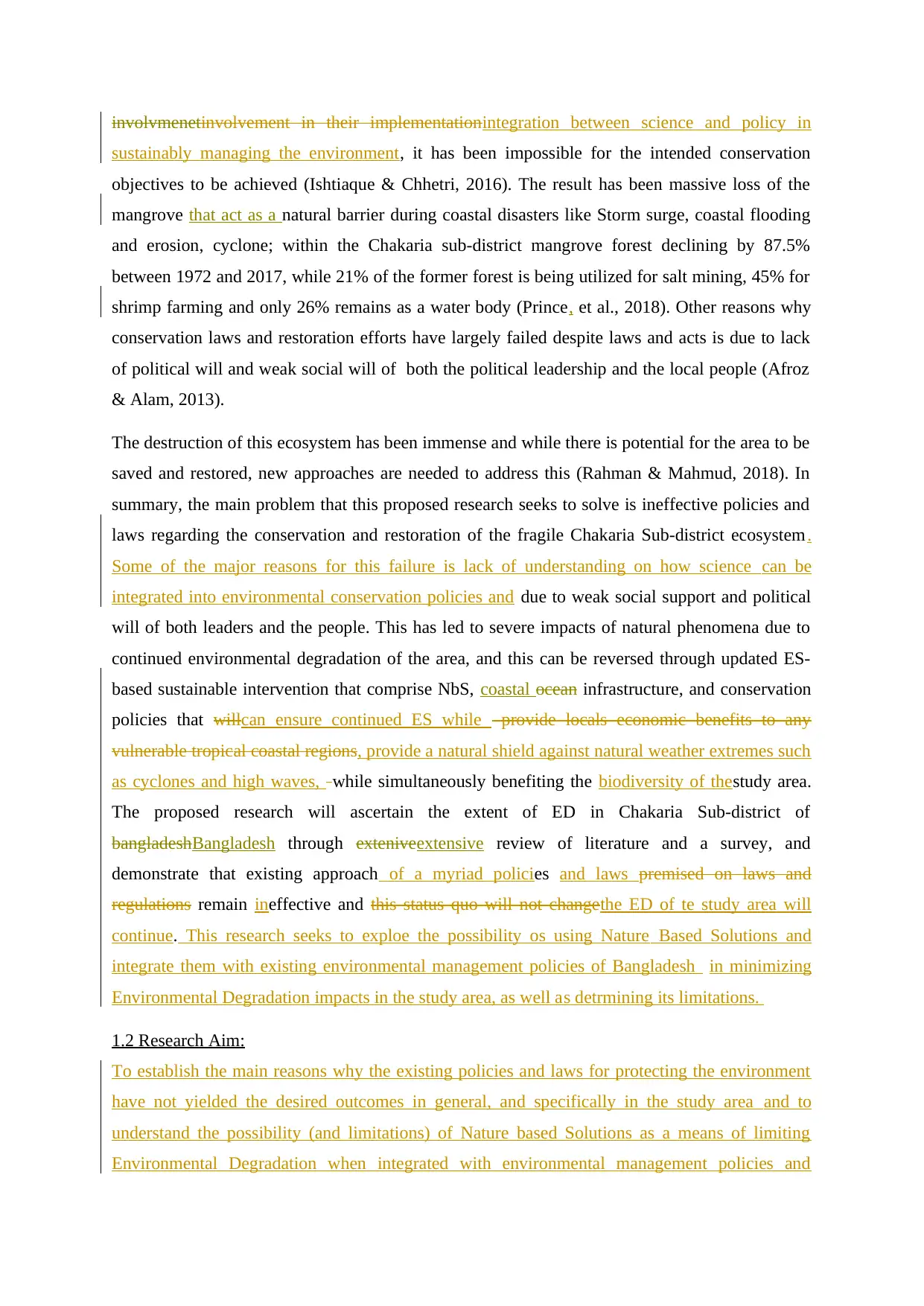
involvmenetinvolvement in their implementationintegration between science and policy in
sustainably managing the environment, it has been impossible for the intended conservation
objectives to be achieved (Ishtiaque & Chhetri, 2016). The result has been massive loss of the
mangrove that act as a natural barrier during coastal disasters like Storm surge, coastal flooding
and erosion, cyclone; within the Chakaria sub-district mangrove forest declining by 87.5%
between 1972 and 2017, while 21% of the former forest is being utilized for salt mining, 45% for
shrimp farming and only 26% remains as a water body (Prince, et al., 2018). Other reasons why
conservation laws and restoration efforts have largely failed despite laws and acts is due to lack
of political will and weak social will of both the political leadership and the local people (Afroz
& Alam, 2013).
The destruction of this ecosystem has been immense and while there is potential for the area to be
saved and restored, new approaches are needed to address this (Rahman & Mahmud, 2018). In
summary, the main problem that this proposed research seeks to solve is ineffective policies and
laws regarding the conservation and restoration of the fragile Chakaria Sub-district ecosystem .
Some of the major reasons for this failure is lack of understanding on how science can be
integrated into environmental conservation policies and due to weak social support and political
will of both leaders and the people. This has led to severe impacts of natural phenomena due to
continued environmental degradation of the area, and this can be reversed through updated ES-
based sustainable intervention that comprise NbS, coastal ocean infrastructure, and conservation
policies that willcan ensure continued ES while provide locals economic benefits to any
vulnerable tropical coastal regions, provide a natural shield against natural weather extremes such
as cyclones and high waves, while simultaneously benefiting the biodiversity of thestudy area.
The proposed research will ascertain the extent of ED in Chakaria Sub-district of
bangladeshBangladesh through exteniveextensive review of literature and a survey, and
demonstrate that existing approach of a myriad policies and laws premised on laws and
regulations remain ineffective and this status quo will not changethe ED of te study area will
continue. This research seeks to exploe the possibility os using Nature Based Solutions and
integrate them with existing environmental management policies of Bangladesh in minimizing
Environmental Degradation impacts in the study area, as well as detrmining its limitations.
1.2 Research Aim:
To establish the main reasons why the existing policies and laws for protecting the environment
have not yielded the desired outcomes in general, and specifically in the study area and to
understand the possibility (and limitations) of Nature based Solutions as a means of limiting
Environmental Degradation when integrated with environmental management policies and
sustainably managing the environment, it has been impossible for the intended conservation
objectives to be achieved (Ishtiaque & Chhetri, 2016). The result has been massive loss of the
mangrove that act as a natural barrier during coastal disasters like Storm surge, coastal flooding
and erosion, cyclone; within the Chakaria sub-district mangrove forest declining by 87.5%
between 1972 and 2017, while 21% of the former forest is being utilized for salt mining, 45% for
shrimp farming and only 26% remains as a water body (Prince, et al., 2018). Other reasons why
conservation laws and restoration efforts have largely failed despite laws and acts is due to lack
of political will and weak social will of both the political leadership and the local people (Afroz
& Alam, 2013).
The destruction of this ecosystem has been immense and while there is potential for the area to be
saved and restored, new approaches are needed to address this (Rahman & Mahmud, 2018). In
summary, the main problem that this proposed research seeks to solve is ineffective policies and
laws regarding the conservation and restoration of the fragile Chakaria Sub-district ecosystem .
Some of the major reasons for this failure is lack of understanding on how science can be
integrated into environmental conservation policies and due to weak social support and political
will of both leaders and the people. This has led to severe impacts of natural phenomena due to
continued environmental degradation of the area, and this can be reversed through updated ES-
based sustainable intervention that comprise NbS, coastal ocean infrastructure, and conservation
policies that willcan ensure continued ES while provide locals economic benefits to any
vulnerable tropical coastal regions, provide a natural shield against natural weather extremes such
as cyclones and high waves, while simultaneously benefiting the biodiversity of thestudy area.
The proposed research will ascertain the extent of ED in Chakaria Sub-district of
bangladeshBangladesh through exteniveextensive review of literature and a survey, and
demonstrate that existing approach of a myriad policies and laws premised on laws and
regulations remain ineffective and this status quo will not changethe ED of te study area will
continue. This research seeks to exploe the possibility os using Nature Based Solutions and
integrate them with existing environmental management policies of Bangladesh in minimizing
Environmental Degradation impacts in the study area, as well as detrmining its limitations.
1.2 Research Aim:
To establish the main reasons why the existing policies and laws for protecting the environment
have not yielded the desired outcomes in general, and specifically in the study area and to
understand the possibility (and limitations) of Nature based Solutions as a means of limiting
Environmental Degradation when integrated with environmental management policies and
Paraphrase This Document
Need a fresh take? Get an instant paraphrase of this document with our AI Paraphraser
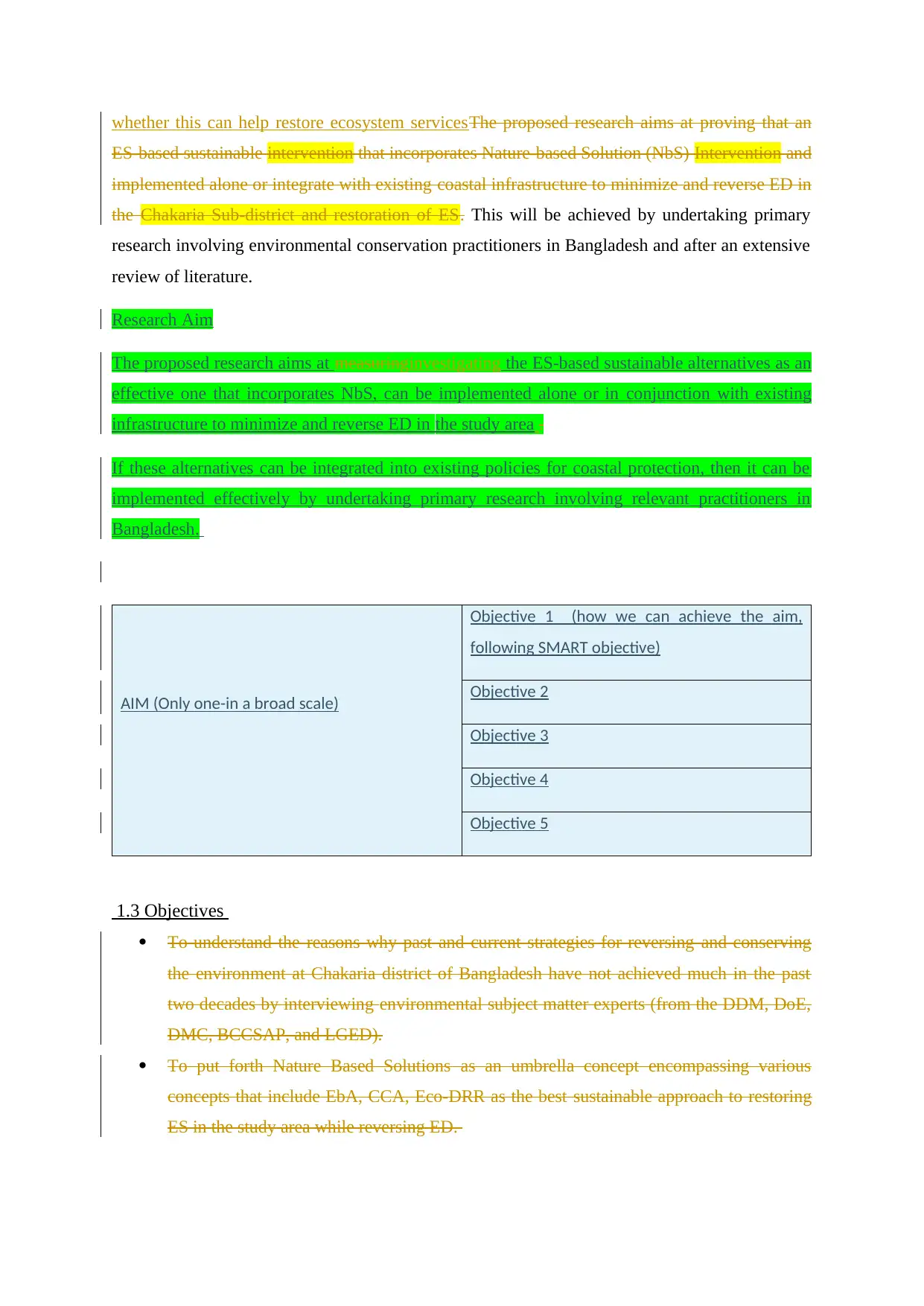
whether this can help restore ecosystem servicesThe proposed research aims at proving that an
ES-based sustainable intervention that incorporates Nature-based Solution (NbS) Intervention and
implemented alone or integrate with existing coastal infrastructure to minimize and reverse ED in
the Chakaria Sub-district and restoration of ES. This will be achieved by undertaking primary
research involving environmental conservation practitioners in Bangladesh and after an extensive
review of literature.
Research Aim
The proposed research aims at measuringinvestigating the ES-based sustainable alternatives as an
effective one that incorporates NbS, can be implemented alone or in conjunction with existing
infrastructure to minimize and reverse ED in the study area .
If these alternatives can be integrated into existing policies for coastal protection, then it can be
implemented effectively by undertaking primary research involving relevant practitioners in
Bangladesh.
AIM (Only one-in a broad scale)
Objective 1 (how we can achieve the aim,
following SMART objective)
Objective 2
Objective 3
Objective 4
Objective 5
1.3 Objectives
To understand the reasons why past and current strategies for reversing and conserving
the environment at Chakaria district of Bangladesh have not achieved much in the past
two decades by interviewing environmental subject matter experts (from the DDM, DoE,
DMC, BCCSAP, and LGED).
To put forth Nature Based Solutions as an umbrella concept encompassing various
concepts that include EbA, CCA, Eco-DRR as the best sustainable approach to restoring
ES in the study area while reversing ED.
ES-based sustainable intervention that incorporates Nature-based Solution (NbS) Intervention and
implemented alone or integrate with existing coastal infrastructure to minimize and reverse ED in
the Chakaria Sub-district and restoration of ES. This will be achieved by undertaking primary
research involving environmental conservation practitioners in Bangladesh and after an extensive
review of literature.
Research Aim
The proposed research aims at measuringinvestigating the ES-based sustainable alternatives as an
effective one that incorporates NbS, can be implemented alone or in conjunction with existing
infrastructure to minimize and reverse ED in the study area .
If these alternatives can be integrated into existing policies for coastal protection, then it can be
implemented effectively by undertaking primary research involving relevant practitioners in
Bangladesh.
AIM (Only one-in a broad scale)
Objective 1 (how we can achieve the aim,
following SMART objective)
Objective 2
Objective 3
Objective 4
Objective 5
1.3 Objectives
To understand the reasons why past and current strategies for reversing and conserving
the environment at Chakaria district of Bangladesh have not achieved much in the past
two decades by interviewing environmental subject matter experts (from the DDM, DoE,
DMC, BCCSAP, and LGED).
To put forth Nature Based Solutions as an umbrella concept encompassing various
concepts that include EbA, CCA, Eco-DRR as the best sustainable approach to restoring
ES in the study area while reversing ED.
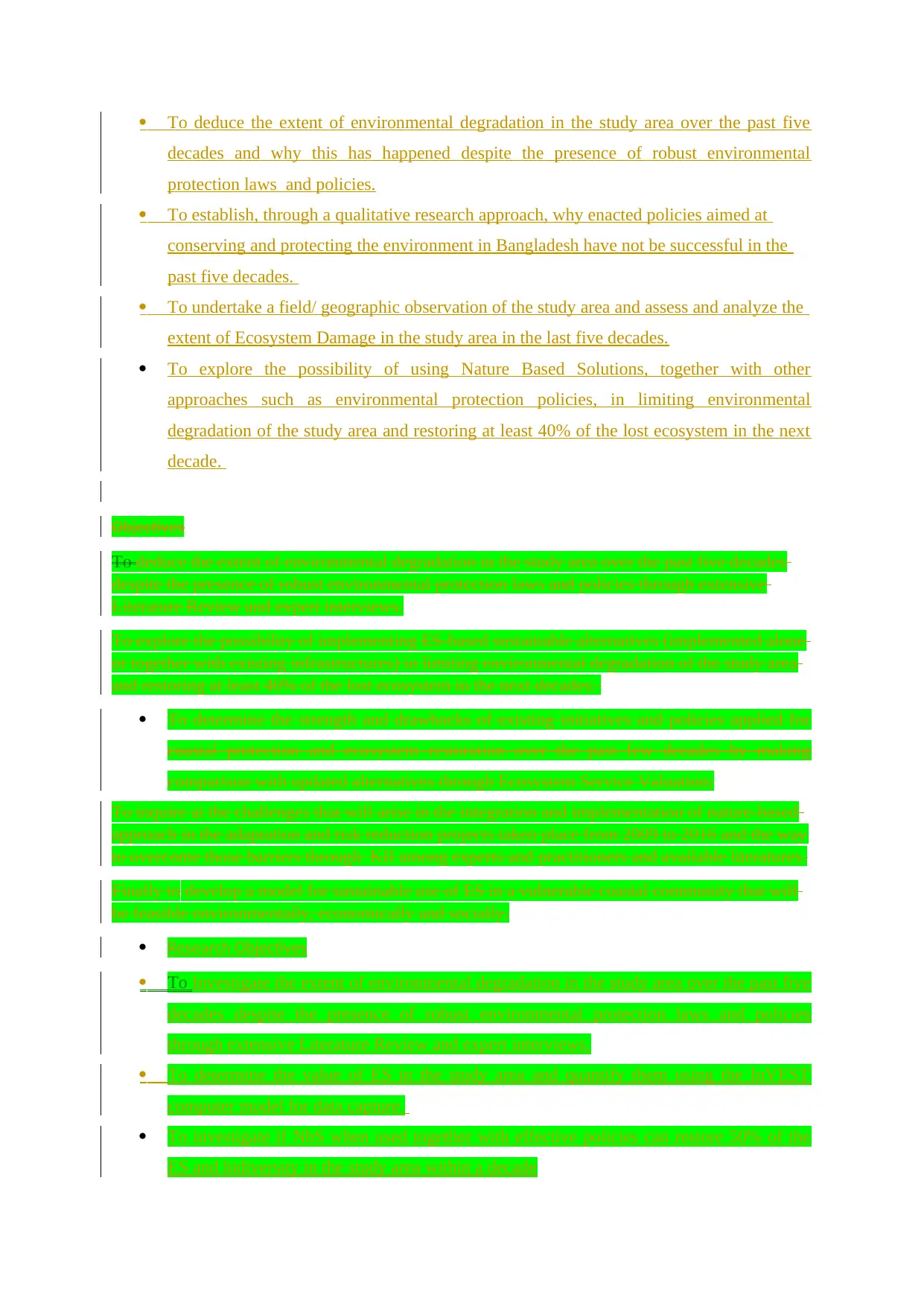
To deduce the extent of environmental degradation in the study area over the past five
decades and why this has happened despite the presence of robust environmental
protection laws and policies.
To establish, through a qualitative research approach, why enacted policies aimed at
conserving and protecting the environment in Bangladesh have not be successful in the
past five decades.
To undertake a field/ geographic observation of the study area and assess and analyze the
extent of Ecosystem Damage in the study area in the last five decades.
To explore the possibility of using Nature Based Solutions, together with other
approaches such as environmental protection policies, in limiting environmental
degradation of the study area and restoring at least 40% of the lost ecosystem in the next
decade.
Objectives
To deduce the extent of environmental degradation in the study area over the past five decades
despite the presence of robust environmental protection laws and policies through extensive
Literature Review and expert interviews.
To explore the possibility of implementing ES-based sustainable alternatives (implemented alone
or together with existing infrastructures) in limiting environmental degradation of the study area
and restoring at least 40% of the lost ecosystem in the next decades.
To determine the strength and drawbacks of existing initiatives and policies applied for
coastal protection and ecosystem restoration over the past few decades by making
comparison with updated alternatives through Ecosystem Service Valuation;
To inquire at the challenges that will arise in the integration and implementation of nature-based
approach in the adaptation and risk reduction projects taken place from 2009 to 2016 and the way
to overcome those barriers through KII among experts and practitioners and available literatures.
Finally to develop a model for sustainable use of ES in a vulnerable coastal community that will
be feasible environmentally, economically and socially.
Research Objectives
To Investigate the extent of environmental degradation in the study area over the past five
decades despite the presence of robust environmental protection laws and policies
through extensive Literature Review and expert interviews.
To determine the value of ES in the study area and quantify them using the InVEST
computer model for data capture.
To investigate if NbS when used together with effective policies can restore 50% of the
ES and bidiversity in the study area within a decade
decades and why this has happened despite the presence of robust environmental
protection laws and policies.
To establish, through a qualitative research approach, why enacted policies aimed at
conserving and protecting the environment in Bangladesh have not be successful in the
past five decades.
To undertake a field/ geographic observation of the study area and assess and analyze the
extent of Ecosystem Damage in the study area in the last five decades.
To explore the possibility of using Nature Based Solutions, together with other
approaches such as environmental protection policies, in limiting environmental
degradation of the study area and restoring at least 40% of the lost ecosystem in the next
decade.
Objectives
To deduce the extent of environmental degradation in the study area over the past five decades
despite the presence of robust environmental protection laws and policies through extensive
Literature Review and expert interviews.
To explore the possibility of implementing ES-based sustainable alternatives (implemented alone
or together with existing infrastructures) in limiting environmental degradation of the study area
and restoring at least 40% of the lost ecosystem in the next decades.
To determine the strength and drawbacks of existing initiatives and policies applied for
coastal protection and ecosystem restoration over the past few decades by making
comparison with updated alternatives through Ecosystem Service Valuation;
To inquire at the challenges that will arise in the integration and implementation of nature-based
approach in the adaptation and risk reduction projects taken place from 2009 to 2016 and the way
to overcome those barriers through KII among experts and practitioners and available literatures.
Finally to develop a model for sustainable use of ES in a vulnerable coastal community that will
be feasible environmentally, economically and socially.
Research Objectives
To Investigate the extent of environmental degradation in the study area over the past five
decades despite the presence of robust environmental protection laws and policies
through extensive Literature Review and expert interviews.
To determine the value of ES in the study area and quantify them using the InVEST
computer model for data capture.
To investigate if NbS when used together with effective policies can restore 50% of the
ES and bidiversity in the study area within a decade
⊘ This is a preview!⊘
Do you want full access?
Subscribe today to unlock all pages.

Trusted by 1+ million students worldwide
1 out of 71
Your All-in-One AI-Powered Toolkit for Academic Success.
+13062052269
info@desklib.com
Available 24*7 on WhatsApp / Email
![[object Object]](/_next/static/media/star-bottom.7253800d.svg)
Unlock your academic potential
Copyright © 2020–2025 A2Z Services. All Rights Reserved. Developed and managed by ZUCOL.


